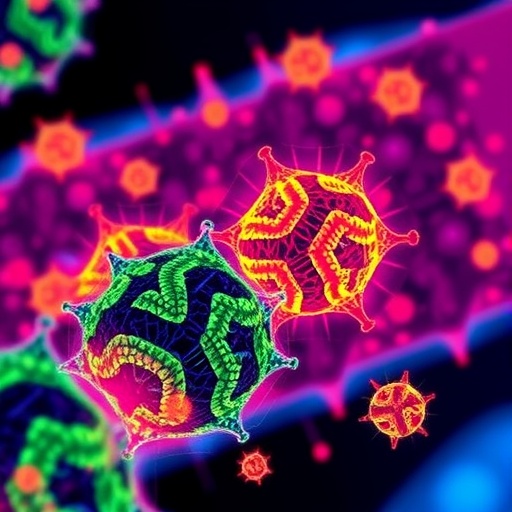Advancing Hematologic Cancer Diagnosis with Spatial Transcriptomics: A Breakthrough from the Josep Carreras Leukemia Research Institute
In the ever-evolving landscape of biomedical science, technological innovation continues to redefine how diseases, particularly cancer, are diagnosed and treated. Among hematologic malignancies—cancers of the blood and lymphatic systems—understanding tumor heterogeneity has presented an immense challenge. Recently, spatial transcriptomics has emerged as a powerful methodology that merges the realms of genomics, transcriptomics, and high-resolution microscopy to analyze gene expression patterns within the spatial context of tissue biopsies. This cutting-edge approach holds the promise to transform diagnostics and personalized therapy for blood cancers.
The Josep Carreras Leukemia Research Institute, a leading center for blood cancer research, has positioned itself at the forefront of this revolution. Led by Dr. Eduard Porta and Dr. Daniela Grases, the Institute has spearheaded efforts to not only utilize spatial transcriptomics but also streamline its application across hematological oncology. By examining gene expression at the single-cell level while preserving the native histological architecture, researchers can decode complex biological behaviors that are otherwise obscured in bulk sequencing methods.
Spatial transcriptomics entails capturing transcriptomic data within intact tissue sections, allowing each cell’s gene expression to be mapped back to its precise location. This spatially resolved molecular information reveals the intricate organization of tumor ecosystems, including malignant cells, stromal components, and immune infiltrates. By visualizing these relationships, scientists gain unprecedented insights into tumor biology, tumor microenvironment interactions, and the spatial dynamics of disease progression.
Despite the immense potential of spatial transcriptomics, the field currently faces significant challenges related to standardization and reproducibility. Variations in technological platforms, differences in sample processing, sequencing depth, and bioinformatic interpretation can yield inconsistent results that hinder cross-study comparisons and clinical translation. Recognizing this bottleneck, the Spatial Biology team at the Josep Carreras Institute consolidated their expertise after analyzing over 1,000 samples to develop the first comprehensive practical guide for spatial transcriptomics protocols.
The guide, recently published in the journal Trends in Biotechnology, provides a detailed roadmap for researchers embarking on spatial transcriptomics studies. It addresses critical decision points such as defining clear biological questions, determining appropriate sample sizes to achieve statistical power, selecting the optimal technological platform suited to specific experimental needs, and implementing rigorous quality control measures. Furthermore, it discusses best practices for data acquisition, processing, and integrative analysis, ensuring methodological robustness.
Dr. Daniela Grases highlights the challenges many laboratories face amid the rapid adoption of spatial transcriptomics: “Groups often struggle with selecting commercial platforms, managing sample integrity, optimizing sequencing parameters, and interpreting complex datasets. Our goal was to distill practical knowledge to foster consistency and reproducibility across spatial biology investigations.” This resource empowers investigators to surmount technical hurdles and promotes coherent frameworks that facilitate meaningful biological insights.
A pivotal aspect of the guide emphasizes the integration of spatial transcriptomics into routine clinical workflows. Achieving this requires overcoming economic constraints posed by expensive reagents and equipment, as well as bridging the expertise gap among clinical laboratory personnel. Nonetheless, the potential benefits for patient care are immense. Incorporating spatially resolved transcriptomics into pathology protocols could enable pathologists to deliver more accurate and nuanced diagnoses, tailor therapeutic regimens with unprecedented precision, and monitor disease evolution dynamically.
The promise of spatial transcriptomics extends beyond traditional bulk sequencing by revealing cellular heterogeneity and tissue architecture simultaneously. Such detailed molecular cartography is expected to unveil novel biomarkers indicative of prognosis and therapeutic response, thereby catalyzing the development of ultra-personalized medicine strategies. For hematological malignancies, where tumor complexity and treatment resistance remain formidable challenges, this technological leap could redefine standard-of-care paradigms.
Moreover, the advancement of analytical tools and computational platforms is critical to fully harness spatial transcriptomics data. Sophisticated algorithms capable of integrating multi-omics datasets with spatial coordinates and histological annotations are being developed to extract actionable knowledge efficiently. The Josep Carreras Leukemia Research Institute remains committed to being a leader not only in method development but also in translating these discoveries into impactful clinical interventions.
While still in its nascency, spatial transcriptomics heralds a transformative era in cancer biology and diagnostics. The proactive measures taken by Dr. Porta, Dr. Grases, and their team to set standards and best practices will likely accelerate scientific progress and clinical adoption. Their work exemplifies how multidisciplinary collaboration and technological innovation converge to unravel the complexities of blood cancer and pave the way toward more effective, individualized therapies.
This pioneering effort is supported by notable funding from the Spanish Ministry of Science, the Josep Carreras Leukemia Foundation, and the FERO-ASEICA Foundation. As spatial transcriptomics technology matures and becomes more accessible, the vision of integrating spatially resolved molecular profiling into everyday clinical pathology may soon become a reality, potentially saving countless lives through earlier, more precise diagnosis and treatment.
Subject of Research: Human tissue samples
Article Title: “A practical guide to spatial transcriptomics: lessons from over 1000 samples”
News Publication Date: 19-Sep-2025
Web References: http://dx.doi.org/10.1016/j.tibtech.2025.08.020
References: Daniela Grases, Eduard Porta-Pardo, “A practical guide to spatial transcriptomics: lessons from over 1000 samples.” Trends in Biotechnology, 2025, ISSN 0167-7799
Image Credits: Josep Carreras Leukemia Research Institute
Keywords: Omics, Genomics, Genomic analysis, Cancer genomics, Blood cancer, Leukemia, Lymphoma, Medical diagnosis
Tags: biomedical science advancementsbulk sequencing limitationsdecoding biological behaviorsgene expression patternshematologic cancer diagnosishigh-resolution microscopy techniquesJosep Carreras Leukemia Research Institutepersonalized therapy for blood cancerssingle-cell level analysisspatial biology innovationspatial transcriptomics breakthroughstumor heterogeneity challenges





